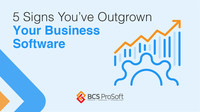We have a lot of articles written about the importance of upgrading your system as well as how to create your own ERP upgrade implementation plan. However, one thing that is often overlooked is how to develop a corporate upgrade strategy and adopt best practices for doing so. So in this article I’m going to explain how to get stakeholders to buy-in to the idea of upgrades, how to calculate your Total Cost of Ownership and even the difficult-to-quantify Total Value of Ownership.
Build an Effective Strategy for Maintaining Your Software Investment
It is very important that your management team and business partners understand the nature of ERP systems so that they can appreciate the importance of having a long-term upgrade strategy. A proper upgrade strategy should span a minimum of five years, and you need to develop a strategic plan for the timing and frequency of upgrade projects. Running the company’s most critical business processes on unsupported software is too risky to be acceptable to most boards of directors.
Strategic planning helps to minimize resistance as management and business leaders realize the necessity of upgrading your solutions, lays out the time frames of the next several projects, and allows for financial and resource planning. It’s very important to recognize that the decision of whether or not to upgrade should not be made by IT.
Getting Buy-in For ERP Upgrade Projects
ERP Upgrades may seem costly, but they are much less expensive and disruptive than replacement projects. A critical part of the upgrade strategy process is educating your workforce to understand ERP upgrades are a normal part of the product life cycle. Upgrade projects should not be seen as IT initiatives; they need to be considered strategic levers to leapfrog the competition by enabling integration, standardization and improvement of business operations across the enterprise. In other words, embracing an up-to-date business management system is less about IT and more about business transformation.
Strategic planning for maintaining your software investment helps to minimize resistance as management and business leaders realize the necessity of upgrading your solutions, lays out the time frames of the next several projects, and allows for financial and resource planning.
Since ERP implementations are tied to the core business strategy, they can trigger process- and operation-level changes across business divisions. This means that employees across the business can be impacted, and may need to learn at least a portion of the enhanced system. Getting buy-in for the upgrade from both managers and end-users by outlining the strategic plan and including visible process improvements and ROI is likely to increase overall user adoption of the new functionality.
New business management systems are typically implemented in phases over several months or years. The phases typically represent groups of modules, business units, geographic locations, or sometimes combinations of all three. The upgrade strategy needs to be positioned as a continuation of that approach, with an annual review that can respond to inevitable changes in the business requirements and incorporate improvements in technology, as well as ways to transform processes to cut costs and improve productivity through new automation and functionality.
In order to get full buy-in to an upgrade process, you will need to do some math. Define the total value of ownership to justify the cost and resources involved in the upgrade. In other words, you need to justify the cost, by clearly articulating the overall value to your business and to individual departments. The next section will outline how to determine the Total Cost of Ownership (TCO) and Total Value of Ownership (TVO). These calculations will help you get buy-in for upgrades and ensure you get the most out of the upgrade process.
Calculating Total Cost of Ownership and Total Value of Ownership
There is no generic one-size-fits-all accepted formula to calculate TCO (Total Cost of Ownership) for business management software, because each organization must consider all relevant costs related to an asset purchase and full expected life cycle—making the calculations is subjective. Some logical reasoning can be applied, which will help you get very close to an equation. Six factors to consider when calculating the TCO of a software upgrade are the:
- Basic Upgrade Price: Is the latest copy of your software delivered to you as part of a software maintenance and support plan? If so, you will have to factor a portion of that cost into your calculations, and will be losing out on some of the main benefits of the plan by not keeping your software system current. If not, and you are receiving a discount on the upgrade version of the software, that is the amount you should consider.
- Additional Database Licenses: When you made your initial ERP purchase, you may have also been required to buy database software, such as Microsoft SQL Server, IBM DB2, MySQL, Linux or Oracle. During the upgrade planning is a perfect time to review your licensing and ensure you have enough licenses to support your growing business.
- Infrastructure: This encompasses the hardware and software located throughout a business, including workstations, servers, processors, memory, and licenses. In addition, a new application might require a dedicated application or web server to effectively handle requests from its users. Don’t forget to consider hardware upgrades, especially if it’s been several years since your initial implementation or your business conditions have changed.
- Professional Services: The cost of any outside assistance must be considered, including upgrade deployment, customizations, integration, and data clean-up, migration or conversion. Don’t forget project management here! Have questions about this part of your upgrade? Get a free ERP Upgrade consultation from BCS ProSoft.
- Internal Staff Deployment: This includes administrators, project managers, developers, and expert report writers. These are the people that enable your organization to access applications concurrently, as well as get the ongoing support to ensure maximize uptime. Enhancements may provide an opportunity to reassess reports and alerts the system generates, and may require some rewriting or program changes.
- Training: An upgrade may require training to maximize the benefits of the enhancements for one group, or many groups in your organization. It is critical to get the most of the tool you have selected in order to maximize your ROI.
Now add these all together and you get your TCO or the expense side of the equation. However, it will be difficult to get buy-in if you stop here, if you focus only on the TCO, then you will have a difficult time justifying the cost. The TVO demonstrates how the technology investment solves key business challenges and justifies the TCO. Think of TVO as the important metric, it takes you beyond simple calculation of the cost, and helps you quantify the true return on investment (ROI) of the purchase. It’s important to not just focus on the functionality of a purchase, but also ask yourself what are the benefits and savings of the purchase?
Involving key groups early in the upgrade process will not only assist you with justifying the associated costs, it will also assist with user adoption and ensure you are truly realizing the value of the new release.
In order to outline the TVO of an upgrade you will need to outline the strategic initiatives you want to address, as well as outline the new functionality and processes you will implement along with the upgrade. Your ERP reseller should be able to provide details on the value of the upgrade, but you will need to determine the actual ROI for your company. The groups within your company that understand the need for these new features are the ones that can develop estimates of potential value. They can provide feedback related to how new features can provide better efficiency, faster response to change, new business models, or improved processes. Involving key groups early in the upgrade process will not only assist you with justifying the associated costs, it will also assist with user adoption and ensure you are truly realizing the value of the new release.
And don’t forget to include the “cost not to solve” in your ROI as well. This is the cost of missed opportunity if you don’t perform the upgrade. For example, Industry associations project that the average inventory overstock is at 35%, with annual turns of 3.5. If you assume one stockroom has a current inventory investment of $20,000, with an annual carrying cost of 27%. And you know that features in the new upgrade will help you better inventory, and your operation yields just a 20% reduction in inventory levels, and a 20% reduction in inventory carrying costs. The math is:
Current Inventory Value is: $20,000 x 20% = $4,000
Carrying Cost Value is: $20,000 x 27%= $5,400
Annual Carrying Cost Savings is: $5,400 x 20% = $1,080
Your first year savings would equal $5,080 and then annually an additional $1,080.00. If you choose not to upgrade the system that allows for better management then your cost of not solving the problem will be $5080.00 the first year and another $1,080.00 until you decide it’s time to upgrade and improve your inventory management.
Calculating the TCO, TVO, and cost not to solve with provide you with return on investment points, while keeping the project focused on transforming the businesses verses a mere IT disruption.







